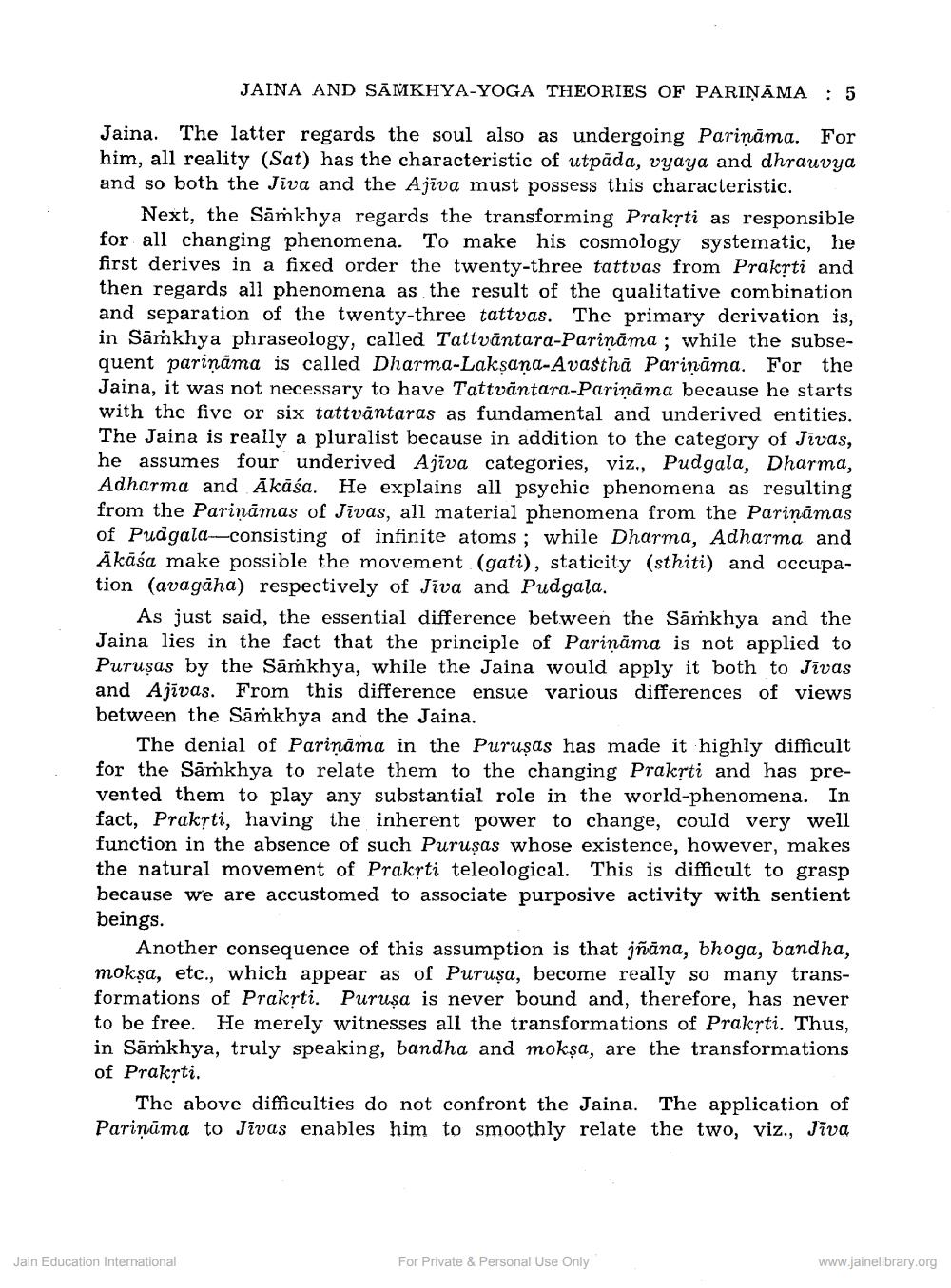Book Title: Comparative Study of Jaina and Samkhya Yoga Theories of Parinama Author(s): Indukala H Zaveri Publisher: Z_Mahavir_Jain_Vidyalay_Suvarna_Mahotsav_Granth_Part_1_012002.pdf and Mahavir_Jain_Vidyalay_Suvarna_ View full book textPage 5
________________ JAINA AND SAMKHYA-YOGA THEORIES OF PARIŅĀMA : 5 Jaina. The latter regards the soul also as undergoing Parinama. For him, all reality (Sat) has the characteristic of utpåda, vyaya and dhrauvya and so both the Jiva and the Ajiva must possess this characteristic. Next, the Samkhya regards the transforming Prakṛti as responsible for all changing phenomena. To make his cosmology systematic, he first derives in a fixed order the twenty-three tattvas from Prakrti and then regards all phenomena as the result of the qualitative combination and separation of the twenty-three tattvas. The primary derivation is, in Samkhya phraseology, called Tattväntara-Parinama; while the subsequent pariņāma is called Dharma-Lakṣaṇa-Avastha Pariņāma. For the Jaina, it was not necessary to have Tattväntara-Parināma because he starts with the five or six tattväntaras as fundamental and underived entities. The Jaina is really a pluralist because in addition to the category of Jivas, he assumes four underived Ajiva categories, viz., Pudgala, Dharma, Adharma and Akāśa. He explains all psychic phenomena as resulting from the Parinamas of Jivas, all material phenomena from the Parinamas of Pudgala-consisting of infinite atoms; while Dharma, Adharma and Akasa make possible the movement (gati), staticity (sthiti) and occupation (avagaha) respectively of Jiva and Pudgala. As just said, the essential difference between the Samkhya and the Jaina lies in the fact that the principle of Parinama is not applied to Purusas by the Samkhya, while the Jaina would apply it both to Jivas and Ajivas. From this difference ensue various differences of views between the Samkhya and the Jaina. The denial of Parinama in the Purusas has made it highly difficult for the Samkhya to relate them to the changing Prakrti and has prevented them to play any substantial role in the world-phenomena. In fact, Prakyti, having the inherent power to change, could very well function in the absence of such Purusas whose existence, however, makes the natural movement of Prakrti teleological. This is difficult to grasp because we are accustomed to associate purposive activity with sentient beings. Another consequence of this assumption is that jñana, bhoga, bandha, mokṣa, etc., which appear as of Purusa, become really so many transformations of Prakyti. Purusa is never bound and, therefore, has never to be free. He merely witnesses all the transformations of Prakyti. Thus, in Samkhya, truly speaking, bandha and moksa, are the transformations of Prakṛti. The above difficulties do not confront the Jaina. The application of Pariņāma to Jivas enables him to smoothly relate the two, viz., Jiva Jain Education International For Private & Personal Use Only www.jainelibrary.orgPage Navigation
1 ... 3 4 5 6
